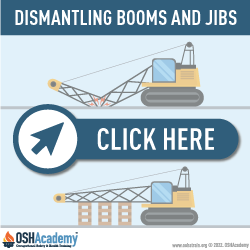Dismantling Booms and Jibs
When pins (or similar devices) are being removed, employees must not be under the boom, jib, or other components, unless site constraints require one or more employees to be in such a position.
In such a case, the A/D director must implement procedures that minimize the risk of unintended dangerous movement and minimize the duration and extent of exposure under the boom.
The following precautions must be taken to prevent dangerous movement of boom and jib sections that are being dismantled.
- None of the pins in the pendants are to be removed (partly or completely) when the pendants are in tension.
- None of the pins (top or bottom) on boom sections located between the pendant attachment points and the crane/derrick body are to be removed (partly or completely) when the pendants are in tension.
- None of the pins (top or bottom) on boom sections located between the uppermost boom section and the crane/derrick body are to be removed (partly or completely) when the boom is being supported by the uppermost boom section resting on the ground (or other support).
- None of the top pins on boom sections located on the cantilevered portion of the boom being removed (the portion being removed ahead of the pendant attachment points) are to be removed (partly or completely) until the cantilevered section to be removed is fully supported.
Fall Protection
During Assembly and Disassembly work, fall protection is generally required when a worker is more than 15 feet above an unprotected side or edge.
Knowledge Check Choose the best answer for the question.
3-8. While performing assembly and disassembly work, you are generally required to wear fall protection when more than ____ feet above an unprotected side or edge.
You forgot to answer the question!

